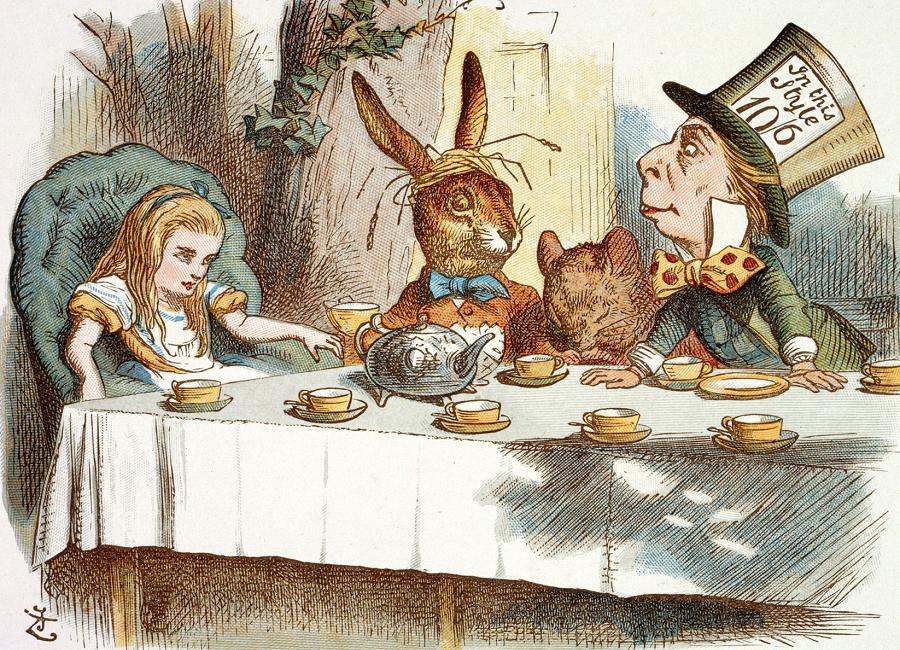Table of Contents
PHILOSOPHY AND ALICE
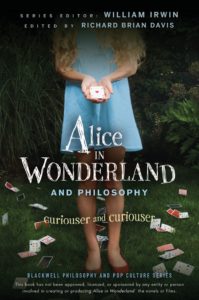
|
Edited by William Irwin and Richard Brian Davis, Alice in Wonderland and Philosophy (Wiley, 2010) is a collection of essays by various authors on the deeper aspects of Wonderland and its characters. Titles include “Unruly Alice: A Feminist View of Some Adventures in Wonderland,” “Six Impossible Things Before Breakfast,” “Is There Such a Thing as Language?” “Serious Nonsense,” and “Memory and Muchness.” For teenagers and up. |
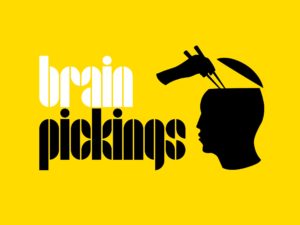 |
From Brainpickings, The Philosophy of Alice in Wonderland is a detailed review of the book, with short excerpts. |
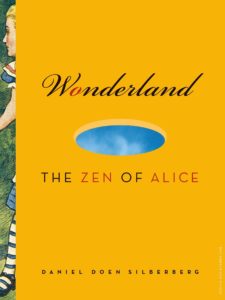 |
Daniel Silberberg’s Wonderland: The Zen of Alice (Parallax Press, 2009) combines quotes and stories from Alice with personal anecdotes, Buddhist koans, and discourses on the nature of reality and the search for truth. A short (120 pages), interesting read for teenagers and up. |
POETRY
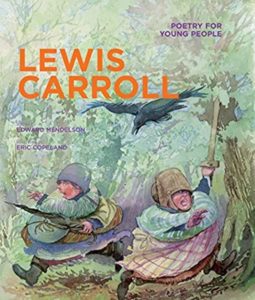
|
Lewis Carroll in the Poetry for Young People series (Sterling, 2008) is an illustrated collection of 26 of Carroll’s best-known poems, among them “How Doth the Little Crocodile,” “You Are Old, Father William,” and “The Walrus and the Carpenter.” For ages 8 and up. |
| Poemhunter’s Lewis Carroll page has a selection of Carroll’s poems including, of course, “Jabberwocky.” | |
| Listen to author Neil Gaiman recite Jabberwocky. |
MATH (AND PUZZLES)
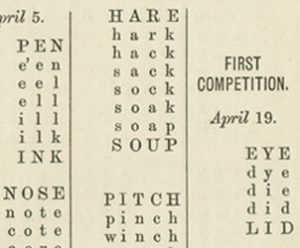 |
One of Lewis Carroll’s puzzle masterpieces is a game/puzzle known as Doublets or Word Ladders, in which players are challenged to change one word into another by changing just one letter at a time. It’s much tricker than it sounds. Check out the link for explanations and examples to try. |
 |
Play on your phone! There are several Word Ladders apps available – for example, see Word Ladder Game from Ventura Educational Systems. |
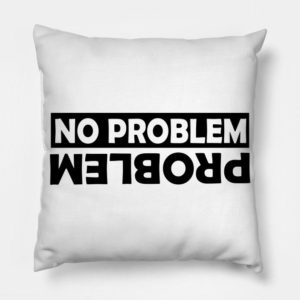 |
In Lewis Carroll’s famous Pillow Problem, a bag contains a counter, known to be either white or black. A white counter is put in, the bag is shaken, and a counter is pulled out, which proves to be white. What is now the chance of drawing a white counter? See Lewis Carroll’s Pillow Problem for a simulation. |
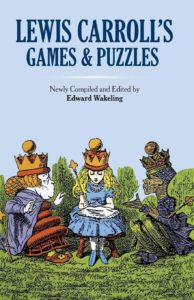 |
Edited by Edward Wakeling, Lewis Carroll’s Games and Puzzles (Dover Publications, 1992) is a collection of 42 brainteasers, among them Looking-Glass Time, Arithmetical Croquet, and Cakes in a Row. For ages 9-12. |
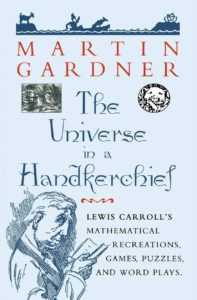 |
Martin Gardner’s The Universe in a Handkerchief (Copernicus, 1998) is a 150-page collection of Lewis Carroll’s “mathematical recreations, games, puzzles, and word plays.” For ages 12 and up. |
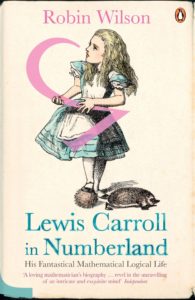
|
Robin Wilson’s Lewis Carroll in Numberland (W.W. Norton, 2010) is a very readable mathematical biography of Carroll – a.k.a. mathematician Charles Dodgson. Included are a chronology of Carroll’s life and explanations of many of the mathematical concepts and puzzles incorporated into his books. For teenagers and adults. |
| Algebra in Wonderland is a short article explaining the math behind some of the events in Alice’s Adventures in Wonderland. Alice’s encounter with the hookah-smoking Caterpillar, for example, has a lot to do with algebra. |
LESSON PLANS
| From Edsitement, A Trip to Wonderland is a lesson plan targeted at grades K-2 based on a young reader’s version of Alice’s Adventures in Wonderland. It centers around imaginative creatures and concepts of size. | |
| From Core Knowledge, Alice in Wonderland is a detailed third-grade level lesson plan to accompany the book. The 12-lesson sequence includes resource and vocabulary lists, activities, and discussion questions. The culminating activity is a mock trial (“Who DID steal the tarts?”). | |
| Targeted at grades 6-8, Edsitement’s Childhood Through the Looking-Glass is a lesson plan in which kids analyze Lewis Carroll’s vision of Victorian childhood and compare it to that of poet William Blake. |
ARTS, CRAFTS, AND ACTIVITIES
| Alice in Wonderland: An Interactive Adventure has a long list of Alice-based games and activities. Kids can solve mazes, read poems (including “Jabberwocky” in Latin), play chess with the Red Queen, put Humpty Dumpty together again, get a recipe for tarts, and more. | |
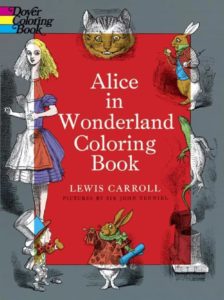 |
The Alice in Wonderland Coloring Book (Dover Publications) includes 36 of the original John Tenniel illustrations (enlarged to coloring-book size) along with an abridged version of the text. |
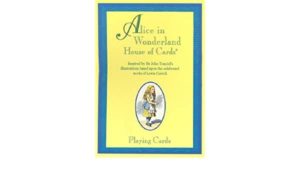 |
Alice in Wonderland House of Cards (U.S. Games Systems) is a set of oversized playing cards featuring John Tenniel’s illustrations, with cut slits so that they can be used for building card houses. (Remember to shout “You’re nothing but a pack of cards!”) |
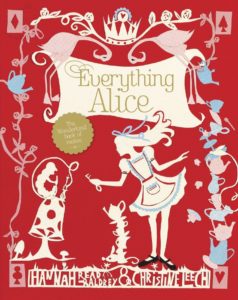
|
By Hannah Read-Baldry and Christine Leech, Everything Alice (North Light Books, 2011) is a collection of craft projects and recipes for Alice lovers. For example, kids and adults can make a stuffed white rabbit, a Cheshire cat mask, lavender dormice, and Duchess macaroons. |
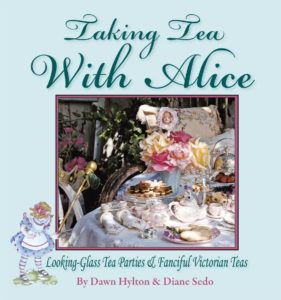 |
By Dawn Hylton and Diane Sedo, Taking Tea With Alice (Benjamin Press, 2008) gives readers the scoop on Alice-style Victorian tea parties, complete with recipes, activities, table settings, decorations, and party games. |
ALICE AT THE MOVIES
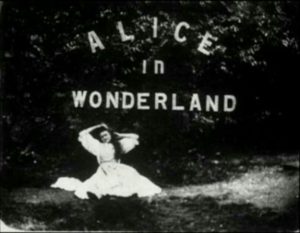 |
See The Ten Best Alice in Wonderland movies, starting with an eight-minute silent film short made in 1903. |
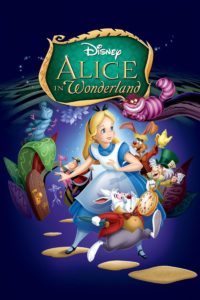 |
Walt Disney’s Alice in Wonderland (1951) is the familiar animated musical. Rated G. |
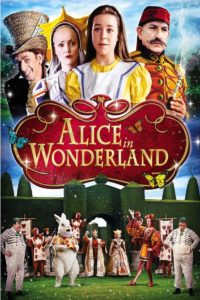
|
Alice in Wonderland (1999) combines Alice’s Adventures in Wonderland and Through the Looking-Glass in a single film, with a cast of characters that includes Whoopi Goldberg as the Cheshire Cat, Ben Kingsley as the Caterpillar, Miranda Richardson as Queen of Hearts, and Peter Ustinov as the Walrus. Rated PG. |
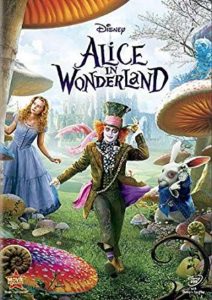
|
In Tim Burton’s 2010 version of Alice in Wonderland, a teenaged Alice falls down a rabbit hole and ends up in a surreal world where – with the help of friends – she has to battle the horrible Jabberwocky and help defeat the Red Queen and restore the White Queen to the throne. The impressive cast includes Johnny Depp as the Mad Hatter, Helena Bonham Carter as the Red Queen, and Anne Hathaway as the White Queen. Rated PG. |
Pages: 1 2
